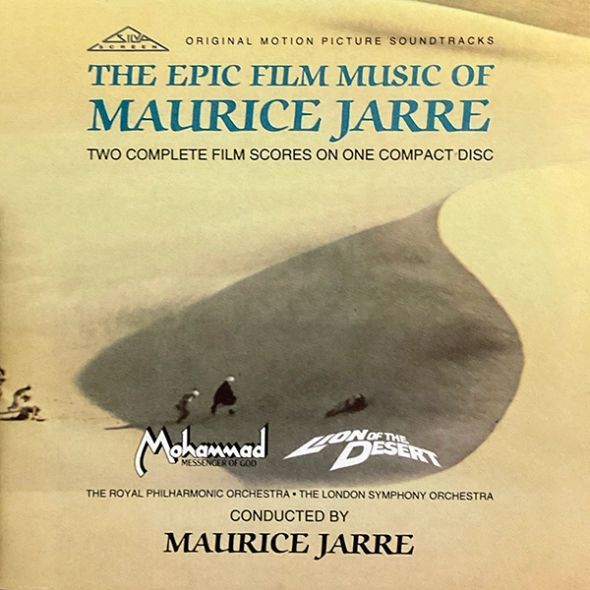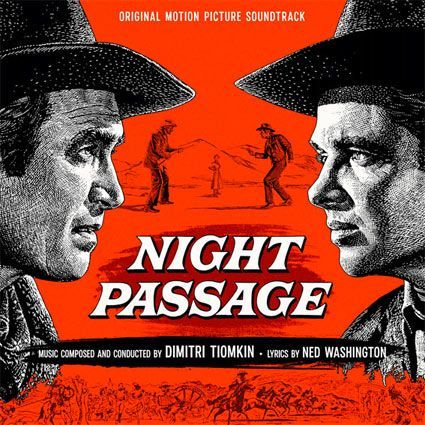The Epic Film Music of Maurice Jarre

Label: Silva Screen Records
Catalogue No: FILMCD 060
Release Date: 1990
Total Duration: 77:01
UPN: 5-014929-006024
These are refreshing recordings to come back to when one wants to escape the moribund electronic scores Maurice Jarre so often does these days. One of Jarre’s greatest strengths is the amazing facility with which he combines western forms with ethnic styles and instrumentation. No wonder Moustapha Akkad and John Huston took up his services for their epic adventures.
EPIC FILM SCORES is a wonderful package. Silva Screen did a fine thing: they could have released the two scores on separate CDs and charged more, but they’ve very generously put them together on one 77 minute CD. The 14-page booklet nearly rivals the Hammer Films release, with reproductions of the spectacular poster artwork, photos from the films, and credits in the original type styles, along with notes on both the composer and the music.
The releases of both films were attended by great controversy. THE MESSAGE raised the ire of Moslems offended by its telling the life story of Mohammed, though in accordance with tradition Mohammed himself is never shown. A history of Mussolini’s brutal attempt to conquer Libya, LION OF THE DESERT was construed by some paranoid American critics as some sort of apology for Moammar Khadhafy.
In his scores for both films, Jarre displays his respect and affection for Arab music and instruments. THE MESSAGE’s music favors panorama over drama – Jarre’s is a colorful score more about idea than personality. Quiet cues like “Hegira” and “The First Martyrs” gracefully combine Arabic instruments with the Ondes Martenot for haunting effect. Others, like “The First Mosque” and the triumphal march “Entry to Mecca” feature bold percussion patterns. “Spread of Islam” is one of many cues that feature what seems to be the score’s primary theme, which the notes reveal as being a variation of the Call of the Muezzin (who summons the Moslems to prayer at the mosque). The Ondes Martenot, backed by distant strings (together, a Jarre trademark) creates an ethereal, dreamy effect. “The Call” also ends the scores in grand fashion in “The Faith of Islam”.
In addition to the color and pageantry (“Fight” by the way, opens and concludes with a lively Arab dance, and features interesting shifts in tone and tempo), Jarre also creates a spiritual level in his score. Is it ironic that there are moments here which plainly recall another Jarre score of this period – JESUS OF NAZARETH? LION OF THE DESERT comes off as more immediately accessible. Here the music dramatizes the conflict between two strong warrior personalities: Italy’s cruel General Graziani and the noble Libyan defender Omar Mukhtar.
“Omar the Teacher” opens the score quite charmingly. His theme opens beautifully, touchingly played alternatingly by strings, muted brass and woodwinds. For three-and-a-half minutes this is a reflective, peaceful version, after which the same theme abruptly transforms itself into a martial air for brass and percussion, with some sweeping variations and striking moments. Also heard is a sort of counter-theme, which portrays Muhktar’s wisdom. “Italian Invasion” features a quote from an actual fascist anthem which is heard when we visit Mussolini in Rome. It’s followed by a dark, compassionate theme for strings that reminds me of the suffering Christ music from, yes, JESUS OF NAZARETH. The cue “Lion of the Desert” features a swirling piano hazily building with other instruments to create an effect worthy of Saint-Saens.
One of the score’s stand-out sequences is “The Concentration Camp”, a tragic lament for chorus and orchestra which reflects the somber grace of the scenes which are melted skillfully to actual documentary footage of the Libyans’ internment. The colorful, uplifting “March of Freedom“ concludes the score. Things do not end well for the hero or his people, but the music possesses a triumphant mood. The strong qualities of Omar, we know, will outlive the powers of his executioners.
Steven J. Lehti – Originally published in Soundtrack Magazine Vol.10 / No.38 / 1991



